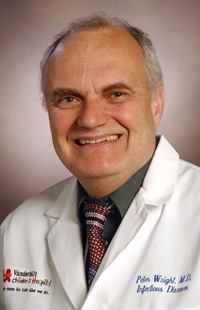
Peter Wright, M.D.
Study tracks infants hit hardest by RSV
Researchers at Vanderbilt University Medical Center are studying why 3 percent of healthy infants get severe bronchiolitis, one of the most severe manifestations of respiratory syncytial virus (RSV).
In addition, researchers want to understand the genetic and environmental factors that predispose these children to become so ill they require hospitalization and why 35-40 percent of these otherwise healthy, full-term infants go on to develop asthma in childhood.
A group of researchers led by Tina Hartert, M.D., M.P.H., assistant professor of Allergy/Pulmonary and Critical Care Medicine, is in the second year of a study of full-term healthy infants with bronchiolitis. They are recruiting infants who are hospitalized as well as a comparison group of infants seen in the PACC at Vanderbilt.
“The fact is over 50 percent of bronchiolitis admissions are full-term, otherwise healthy babies,” Hartert said. “Why do they get so sick from the viruses? We have shown that the rate of subsequent development of childhood asthma among these healthy infants hospitalized with bronchiolitis is extraordinarily high; nearly five times that of the general population. Why?
“We believe that there are genetic and environmental factors common in the pathway from severe bronchiolitis to asthma, and if we can determine what predisposes these children to severe sequelae of viral infection we can potentially prevent these severe illnesses and possibly alter the course of childhood asthma.”
Although there is a set group of children who are known to be at increased risk of developing RSV bronchiolitis and who have established risk factors, the more than 450 mother-infant pairs in this unique study group do not fall into those categories. They are the 50 percent of bronchiolitis hospitalizations who are full-term, otherwise healthy infants.
Hartert expects enrollment to be complete by the end of the year. The infants will be followed until they are 18 months old, she said.













